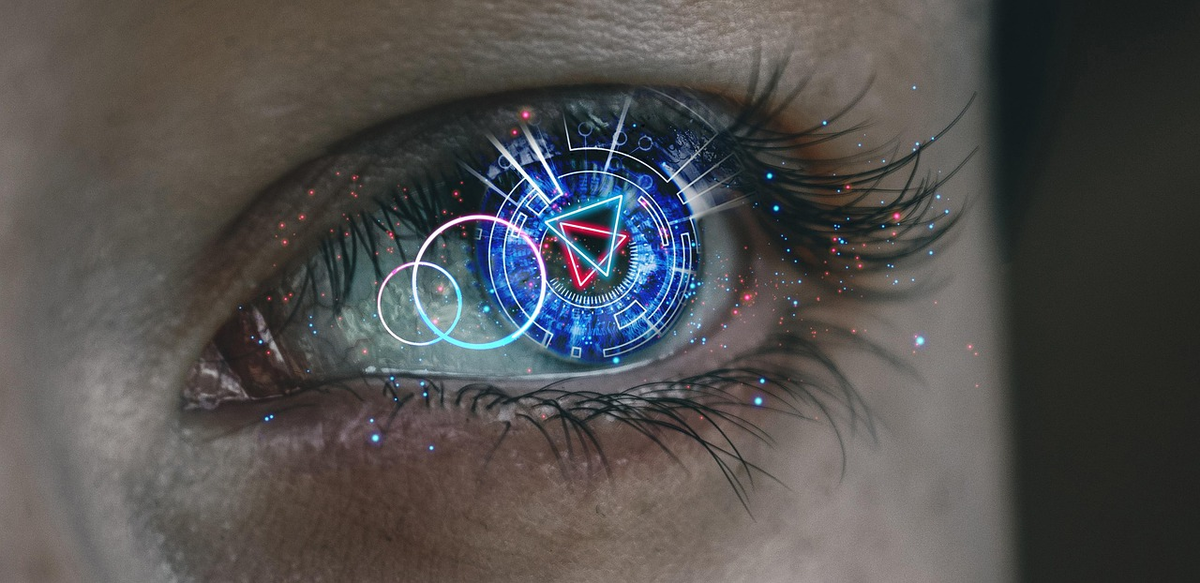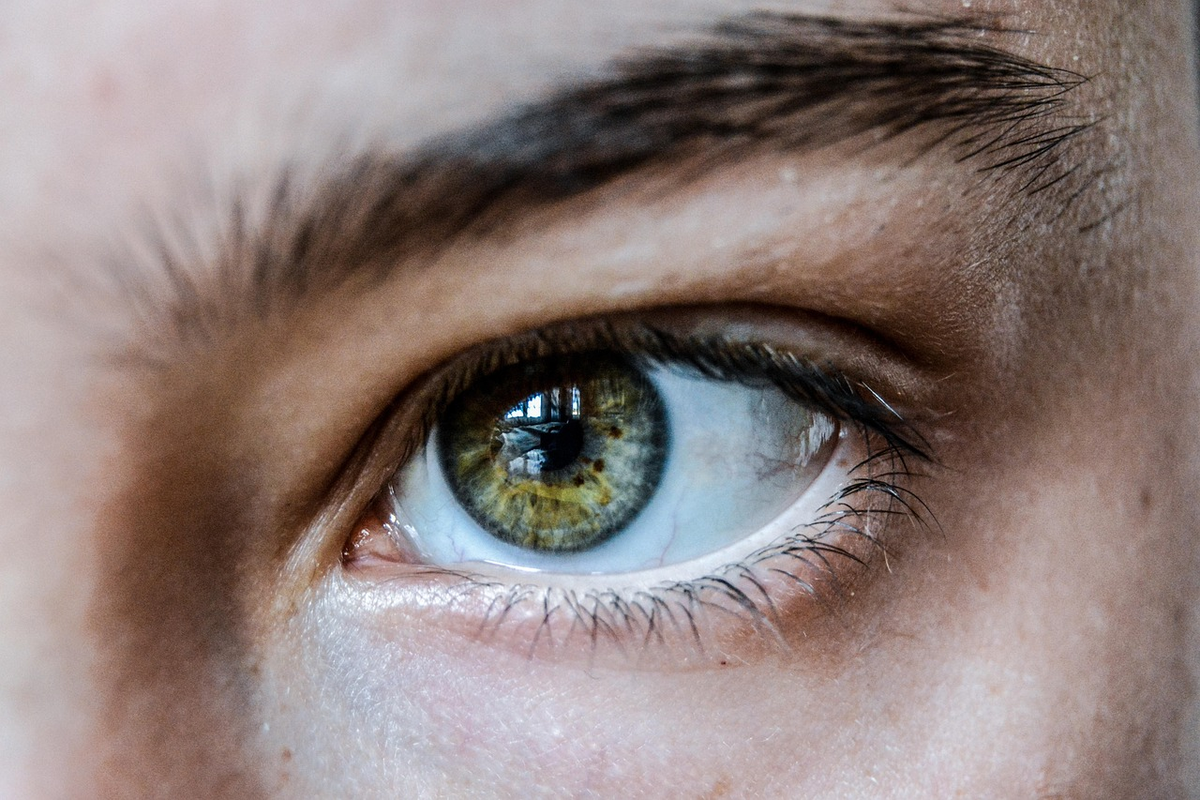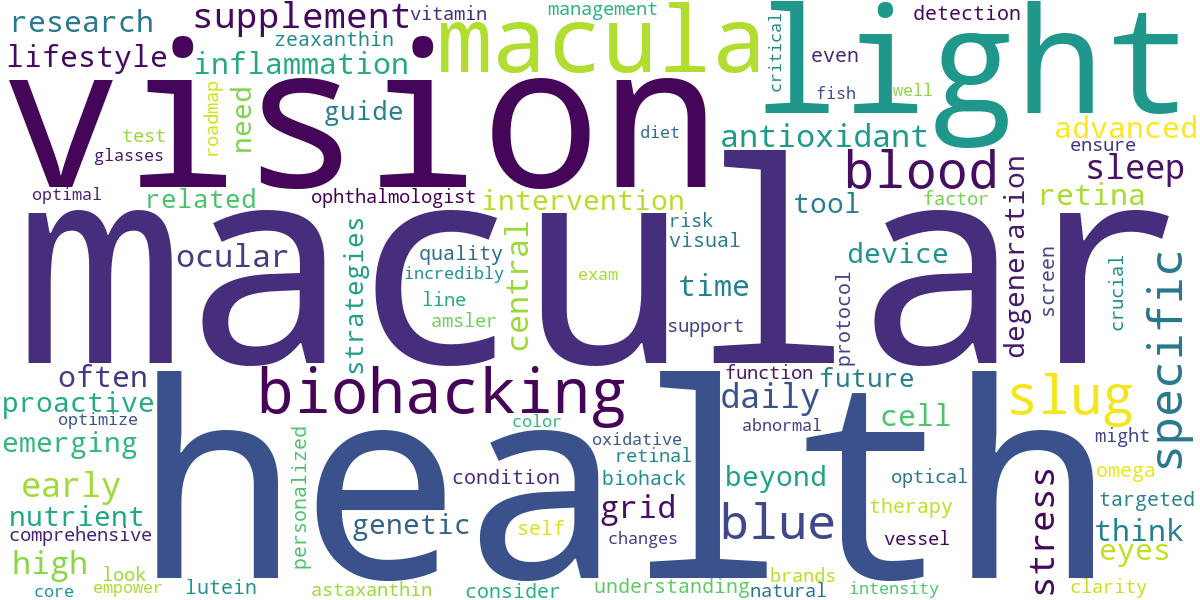
What if you didn’t have to accept age-related vision decline as an inevitable part of aging? Imagine a future where you proactively safeguard your most precious sense, maintaining clarity and independence well into your golden years.
For a complete overview of this topic, refer to our main guide on Biohacking Vision: The Ultimate Guide to Eye Health & Clarity.
This definitive guide on Biohacking Macular Health isn’t just about preventing disease; it’s about empowering you with cutting-edge knowledge and actionable strategies to optimize your vision and overall well-being. Prepare to transform your understanding of eye health from reactive to profoundly proactive.
💡 Key Takeaways
- Empower yourself with proactive strategies to protect macular health, moving beyond traditional reactive approaches.
- Discover a blend of foundational lifestyle adjustments and advanced biohacking techniques tailored for optimal vision preservation.
- Learn the critical importance of early detection and how to implement a personalized roadmap for long-term ocular well-being.
- Understand how diet, supplements, light exposure, and technology collectively contribute to preventing age-related vision decline.
In This Article
- — 💡 Key Takeaways
- → 🔍 Understanding & Early Detection
- — 🔍 Recognizing the Early Warnings
- — 👁️ At-Home Detection: The Amsler Grid
- — 🩺 Professional Detection: Beyond the Grid
- → 🌱 Core Biohacking & Lifestyle
- — 🍎 Nutritional Powerhouse: Fueling Your Macula
- — 💡 Intelligent Light Management: Your Visual Environment
- — 🧘♀️ Holistic Pillars: Sleep, Stress, & Movement
- → 💡 Advanced Biohacks & Tools
- — 💡 Red Light Therapy (RLT) for Macular Rejuvenation
- — ⚙️ How to Apply RLT for Eye Health
- — 💊 Optimized Supplement Stacking & Targeted Delivery
- — 🔬 Key Nutrients for Advanced Macular Support
- — 🧬 Delivery & Absorption Matters
- → 🛣️ Managing & Future Outlook
- — ✅ Continuous Monitoring & Proactive Adaptation
- — 🔭 Emerging Therapies & The Horizon of Innovation
- — ✨ Empowering Your Future Vision
- → 🗺️ Personalized Roadmap
- — 🔍 Your Personal Blueprint: Assessment
- — ⚙️ Tailoring Your Biohacking Stack: Precision Interventions
- — 🔄 Monitor & Adjust: Your Dynamic Path
🔍 Understanding & Early Detection

Your vision is arguably your most precious sense, and at its core, the macula is the tiny, powerhouse engine that makes sharp, detailed central vision possible. Think of your eye as a high-definition camera, and the macula is the incredibly sensitive, high-resolution sensor right in the middle, responsible for everything from reading fine print to recognizing faces and seeing vibrant colors. It’s what allows you to focus on the world’s intricate details.
However, as we age, this vital component can become vulnerable. The primary culprit is Age-related Macular Degeneration (AMD), a progressive eye condition that damages the macula, leading to blurred central vision or blind spots. It’s like your HD sensor starting to develop dead pixels or a blurry patch right where you need clarity most. There are two main types:
- ✅ Dry AMD: The most common form (about 80-90% of cases), characterized by the thinning of the macula and the formation of small yellow deposits called drusen. It progresses slowly, but can lead to significant vision loss.
- ✅ Wet AMD: Less common but more severe, occurring when abnormal blood vessels grow under the macula, leaking fluid or blood. This can cause rapid, severe central vision loss. Think of it as a sudden, damaging flood over your camera’s sensor.
🔍 Recognizing the Early Warnings
The insidious nature of AMD is that early symptoms can be subtle, easily dismissed, or even unnoticed because your other eye compensates. This is why vigilance is key. What should you be on the lookout for? Imagine you’re looking at a tiled wall:
- ✅ Distortion of Straight Lines: Are the lines on that tiled wall suddenly appearing wavy, bent, or broken? This is often one of the first and most critical signs. A door frame might look crooked, or a telephone pole might seem bent.
- ✅ Blurred Central Vision: Difficulty reading, recognizing faces, or seeing details in the center of your visual field, while peripheral vision remains relatively clear.
- ✅ Dark or Blank Spots: A “smudge” or “hole” in your central vision.
- ✅ Decreased Intensity or Brightness of Colors: Colors might seem duller or less vibrant than before.
- ✅ Difficulty Adapting to Low Light: Taking longer to adjust when moving from a brightly lit area to a dim one.
👁️ At-Home Detection: The Amsler Grid
One of the most powerful, yet simple, tools you have for early self-detection is the Amsler Grid. This is a square grid of straight lines with a dot in the center. It’s freely available online (just search “Amsler Grid” and print it out) or can be obtained from your eye doctor. It’s your daily macula health check-up, taking mere seconds.
Here’s how to use it effectively:
- Find a well-lit area and hold the grid at a normal reading distance (about 12-14 inches).
- Cover one eye completely.
- Focus your open eye directly on the central dot. Do NOT let your eye wander from the dot.
- While staring at the dot, quickly note if any lines appear wavy, broken, distorted, blurry, or if any areas look blank or dark.
- Repeat the process with your other eye.
If you notice any new changes or distortions, it’s a red flag. This proactive vigilance is a cornerstone of the biohacking philosophy, as detailed in resources like the Biohackers Handbook, which emphasizes taking charge of your own health monitoring.
🩺 Professional Detection: Beyond the Grid
While the Amsler Grid is an excellent first line of defense, it doesn’t replace regular, comprehensive eye exams. Your optometrist or ophthalmologist has sophisticated tools to detect changes long before you might notice them. These include:
- ✅ Dilated Eye Exam: After dilating your pupils (which makes them wider), your doctor can get a clear, magnified view of your macula and other structures at the back of your eye, looking for drusen or other abnormalities.
- ✅ Optical Coherence Tomography (OCT): This non-invasive imaging test is revolutionary. Think of it as an “optical ultrasound” or an “optical biopsy” that takes cross-sectional images of your retina. It provides incredibly detailed views of the retinal layers, allowing your doctor to see swelling, fluid leakage, or the presence of abnormal blood vessels that are hallmarks of wet AMD, often before symptoms even appear. It’s like having an X-ray of your macula.
- ✅ Fluorescein Angiography: If wet AMD is suspected, a special dye is injected into your arm, which travels to your eyes. Photographs are then taken as the dye passes through the blood vessels in your retina, revealing any leakage or abnormal vessel growth.
Early detection is not just a buzzword for macular health; it’s the critical difference between managing a condition and facing severe vision loss. By understanding what to look for and utilizing both at-home checks and professional evaluations, you empower yourself to protect your central vision for years to come.
- What is Age-Related Macular Degeneration (AMD)? A Beginner’s Guide
- Uncovering AMD Risk Factors: Genetics, Lifestyle, and Environmental Influences
- Detecting AMD Early: Understanding Diagnostic Tools and Self-Monitoring
🌱 Core Biohacking & Lifestyle

Welcome to the core of optimizing your vision: the foundational biohacking and lifestyle strategies that empower your eyes, especially your macula, to thrive. Think of your eyes not just as organs of sight, but as incredibly complex, energy-demanding sensors. Just as a high-performance vehicle requires premium fuel and diligent maintenance, your macula needs a precise blend of nutrients, intelligent environmental management, and holistic self-care to function optimally and resist the relentless march of time.
🍎 Nutritional Powerhouse: Fueling Your Macula
Your diet isn’t just about general health; it’s a direct determinant of your macular integrity. You need to understand that your macula, like any high-performance engine, runs optimally on premium fuel. The right dietary choices are not just beneficial; they are fundamental. Emerging research, including comprehensive reviews on nutritional factors and their benefits in ophthalmologic diseases, strongly supports the role of specific compounds in maintaining eye health and potentially mitigating vision decline.
- ✅ Macula-Specific Micronutrients: Focus on foods rich in Lutein and Zeaxanthin. These carotenoids are like internal sunglasses, filtering harmful blue light and acting as powerful antioxidants within your macula. Think deep green leafy vegetables:
- Spinach: A cup of cooked spinach packs over 20mg of Lutein + Zeaxanthin.
- Kale: Another powerhouse, excellent in smoothies or salads.
- Broccoli, peas, corn, and egg yolks (especially pasture-raised, which have higher carotenoid content) are also great sources. Aim for a generous serving daily.
- ✅ Omega-3 Fatty Acids (DHA & EPA): The retina is rich in DHA, making it crucial for photoreceptor cell function and reducing inflammation.
- Incorporate fatty fish like wild-caught salmon, mackerel, sardines, or anchovies (SMASH fish) 2-3 times per week.
- If fish isn’t your preference, consider a high-quality, third-party tested fish oil supplement, targeting at least 1000mg of combined EPA/DHA daily. My go-to brands often include Nordic Naturals or Thorne.
- ✅ Antioxidant Richness: Your macula is under constant oxidative stress. Arm it with a diverse array of antioxidants.
- Vitamin C: Bell peppers, citrus fruits, berries.
- Vitamin E: Nuts (almonds, hazelnuts), seeds (sunflower), avocados.
- Zinc: Oysters, beef, pumpkin seeds, lentils. Crucial for transporting Vitamin A from the liver to the retina.
- Astaxanthin: This super-antioxidant, found in microalgae and giving salmon its pink color, has incredible protective effects for the eyes. Consider a supplement aiming for 4-12mg daily.
- ✅ Hydration: While seemingly simple, adequate hydration ensures proper nutrient delivery and waste removal to and from your delicate eye tissues. Aim for pure, filtered water throughout the day.
💡 Intelligent Light Management: Your Visual Environment
In our modern world, we’re bombarded by light, not all of it beneficial. Mastering your light environment is a critical biohack for macular health.
- ✅ Strategic Blue Light Blocking: Excess blue light, particularly from screens, can contribute to oxidative stress in the macula.
- Digital Hygiene: Use the “Night Shift” (iOS) or “Night Light” (Android/Windows) features on your devices, setting them to warmer tones, especially after sunset.
- Blue Light Blocking Glasses: Invest in high-quality blue-light-filtering glasses for daytime screen use. For evening use, consider amber- or red-tinted lenses (e.g., from brands like Ra Optics or Swannies) that block nearly 100% of blue and green light, signaling to your brain that it’s time for sleep (which is also crucial for eye repair).
- ✅ Harnessing Red Light Therapy: Low-level red and near-infrared light (630-850nm) has shown promising benefits for mitochondrial function in retinal cells, potentially enhancing energy production and cellular repair.
- Targeted Devices: You can explore specific red light therapy devices designed for ocular use, or use a full-body panel (e.g., Joovv, Mito Red Light) by shining it near your eyes for 5-15 minutes a few times a week, ensuring the device is at a safe distance and intensity. Always consult a professional or manufacturer guidelines for eye-specific protocols.
🧘♀️ Holistic Pillars: Sleep, Stress, & Movement
Beyond the direct inputs, your overall physiological state profoundly impacts your macular health.
- ✅ Prioritize High-Quality Sleep: Sleep is when your body, including your eyes, undergoes essential repair and regeneration. Chronic sleep deprivation elevates systemic inflammation and compromises cellular recovery.
- Sleep Hygiene: Aim for 7-9 hours of uninterrupted sleep. Maintain a consistent sleep schedule, ensure your bedroom is completely dark and cool, and avoid screens for at least 60-90 minutes before bed.
- ✅ Master Stress Management: Chronic stress elevates cortisol, which can contribute to systemic inflammation and impact blood flow. Your eyes are highly vascularized and susceptible to changes in blood pressure and circulation.
- Mindfulness Practices: Integrate daily stress-reducing activities like meditation (even 10 minutes can make a difference), deep breathing exercises (e.g., Box Breathing), or gentle yoga.
- Time in Nature: Spending time outdoors, away from screens, can significantly reduce stress and offer natural light exposure beneficial for circadian rhythm.
- ✅ Regular Movement & Exercise: Physical activity enhances overall circulation, ensuring a robust blood supply to your eyes, delivering vital nutrients and removing metabolic waste.
- Cardiovascular Health: Engage in moderate-intensity exercise (brisk walking, cycling, swimming) for at least 150 minutes per week.
- Resistance Training: Strength training helps regulate blood sugar and improve metabolic health, both indirectly beneficial for eye health.
By consistently implementing these core biohacking and lifestyle principles, you’re not just hoping for better vision; you are actively engineering it, providing your macula with the optimal environment to thrive and maintain its clarity for years to come.
- Biohacking Strategies for AMD Prevention: A Proactive Approach to Macular Health
- Diet and Macular Health: Optimizing Nutrition to Combat AMD
- The Best Supplements for Macular Health: A Guide to AREDS, Lutein, and More
- Power of Antioxidants: Protecting Macular Cells from Oxidative Stress
- Lifestyle Interventions for Macular Health: Beyond Diet and Supplements
💡 Advanced Biohacks & Tools

You’ve mastered the fundamentals – eating your leafy greens, wearing your blue light blockers. But what if you could tap into cutting-edge strategies, leveraging the very latest in science and technology to not just protect, but truly optimize your macular health? Welcome to the realm of advanced biohacks and tools, where we go beyond prevention and dive into performance.
💡 Red Light Therapy (RLT) for Macular Rejuvenation
Imagine giving the powerhouses of your eye cells – your mitochondria – a direct energy boost. That’s essentially what targeted Red Light Therapy, specifically in the 670nm (red) to 810nm (near-infrared) spectrum, aims to do for your macula. Think of it like charging a low battery; by delivering specific wavelengths of light, you can enhance cellular energy production (ATP synthesis), reduce inflammation, and support cellular repair mechanisms within your retina.
⚙️ How to Apply RLT for Eye Health
- ✅ Dedicated Devices: For optimal safety and efficacy, consider devices specifically designed for ocular use, or general RLT panels that allow for precise distance and controlled exposure. Brands like GembaRed or specialized eye masks (ensuring they use the correct wavelengths and intensity) are gaining traction in the biohacking community.
- ✅ Wavelength Focus: Research often points to wavelengths around 670nm for superficial tissue benefits and 810nm for deeper penetration. Some devices combine these.
- ✅ Protocol: A common protocol involves brief, daily sessions – often just 3-5 minutes per eye, at a comfortable distance. Always follow the manufacturer’s instructions and start slowly. It’s not about intensity, but consistent, low-level stimulation.
💊 Optimized Supplement Stacking & Targeted Delivery
While the basics of AREDS2 are crucial, advanced biohacking involves a more nuanced approach to nutrient intake, focusing on specific forms and synergistic combinations that offer enhanced protective and regenerative capabilities.
🔬 Key Nutrients for Advanced Macular Support
- ✅ Lutein & Zeaxanthin (including Meso-Zeaxanthin): These aren’t just buzzwords; they are the pigments that naturally accumulate in your macula, forming a protective filter against harmful blue light and acting as powerful antioxidants. Their combined, synergistic power is critical, as highlighted in a comprehensive review on their potential roles in macular health. Look for supplements that provide all three isomers, often derived from Marigold flower extract.
- ✅ Astaxanthin: Often called the “King of Carotenoids,” Astaxanthin is an incredibly potent antioxidant (far more powerful than Vitamin E or Beta-Carotene) that can cross the blood-retinal barrier, offering superior protection against oxidative stress and inflammation within the eye. Dose ranges from 4mg to 12mg daily.
- ✅ Saffron (Crocus sativus): Emerging research suggests Saffron’s unique compounds, particularly crocin and crocetin, have neuroprotective and antioxidant effects that may support retinal function and improve visual acuity in certain conditions. Look for standardized extracts.
- ✅ Omega-3 Fatty Acids (DHA & EPA): Specifically DHA is a major structural component of the retina. Ensuring adequate intake, ideally from high-quality fish oil (e.g., IFOS certified) or algal oil, is paramount for maintaining retinal cell membrane fluidity and function. Aim for at least 1000mg of combined DHA/EPA daily.
🧬 Delivery & Absorption Matters
It’s not just what you take, but how well your body can utilize it. Consider supplements with enhanced bioavailability. For example, some Astaxanthin formulations are designed for better absorption, and liposomal delivery systems for certain nutrients can bypass digestive hurdles, getting more active compounds where they need to go. Always opt for third-party tested, high-quality brands to ensure purity and potency.
- Red Light Therapy for Macular Degeneration: Emerging Biohacks for Vision
- Boosting Macular Pigment Optical Density (MPOD): Key to Retinal Protection
- Best Blue Light Blocking Glasses for Macular Protection: A Buyer’s Guide
🛣️ Managing & Future Outlook

Navigating the terrain of macular health isn’t just about initial prevention; it’s a dynamic, lifelong journey of proactive management and an exciting exploration of future possibilities. You’ve already taken monumental steps by understanding the foundational biohacks. Now, let’s talk about the long game – how to maintain that edge and what’s on the horizon for safeguarding your central vision.
✅ Continuous Monitoring & Proactive Adaptation
- The Annual Check-Up: Your Eye’s Comprehensive MOT. Just as you wouldn’t skip a physical for your overall health, annual comprehensive eye exams are non-negotiable. These aren’t just for checking your prescription; they’re deep dives into your ocular anatomy. Your ophthalmologist will likely perform:
- Dilated Fundus Exam: This allows a wide, clear view of your retina and macula.
- Optical Coherence Tomography (OCT): Think of this as an MRI for your retina. It provides cross-sectional images, revealing incredibly subtle changes in macular thickness or the presence of fluid, often long before you notice symptoms. It’s an indispensable tool for early detection of issues like Age-related Macular Degeneration (AMD) or Diabetic Macular Edema (DME).
- Amsler Grid Test: This simple grid, which you can even do at home, helps you monitor for distortions or blind spots in your central vision – early warning signs that require immediate attention.
- Refining Your Biohacking Protocol. Your body is constantly evolving, and so should your strategy. Review your supplement stack with your healthcare provider periodically. Are you getting sufficient Omega-3s, Lutein, Zeaxanthin, and Astaxanthin? Are your blood markers for inflammation or nutrient deficiencies still optimal? This iterative process ensures your biohacking efforts remain precisely calibrated to your needs.
🔭 Emerging Therapies & The Horizon of Innovation
For those facing more advanced stages of macular degeneration, particularly the “wet” form, the landscape of treatment has evolved dramatically. While these interventions are typically managed by an ophthalmologist, understanding them empowers you:
- Anti-VEGF Injections: Halting the Progression. For wet AMD, where abnormal blood vessels leak fluid and blood, treatments like Lucentis (ranibizumab), Eylea (aflibercept), and Beovu (brolucizumab) have revolutionized outcomes. These medications block Vascular Endothelial Growth Factor (VEGF), a protein that stimulates abnormal vessel growth, effectively drying up the macula and often preserving significant vision. This is a testament to targeted pharmacological intervention.
- Complement Inhibitors: A New Frontier. Research is increasingly focusing on the complement system, a part of the immune system implicated in the dry form of AMD. Drugs like Syfovre (pegcetacoplan) and Izervay (avacincaptad pegol) are now available for geographic atrophy (advanced dry AMD), aiming to slow its progression. This represents a significant leap in managing what was once considered untreatable.
- Novel Approaches to Vitreous Health. Beyond direct macular treatments, ongoing research into the vitreous (the jelly-like substance filling your eye) offers exciting prospects. Conditions like vitreomacular traction, where the vitreous pulls on the macula, can impair vision. Emerging pharmacological vitreolysis, using compounds like lumbrokinase and nattokinase, is being explored for its potential to gently detach the vitreous from the macula, alleviating traction and protecting central vision, as highlighted in a recent study on pharmacological vitreolysis. Imagine a future where a supplement could mitigate conditions that previously required more invasive interventions.
- Gene Therapy & Stem Cell Research: The Distant Horizon. While not yet mainstream, gene therapy holds immense promise for correcting genetic defects that predispose individuals to certain types of macular degeneration. Similarly, stem cell research aims to replace damaged macular cells, potentially restoring lost vision. These fields are still in active development but represent the ultimate frontier in regenerative ophthalmology.
✨ Empowering Your Future Vision
Your journey with macular health is a testament to your commitment to self-optimization. The key is to remain informed, proactive, and resilient. Partner closely with your ophthalmologist, ask questions, and don’t hesitate to seek second opinions. Understanding your condition, embracing the best current practices, and keeping an eye on the innovations emerging from the scientific community ensures you remain at the forefront of protecting your most precious sense – your vision.
- Advanced Biohacking Protocols for Dry AMD: Managing Early and Intermediate Stages
- Biohacking Support for Wet AMD: Complementary Strategies to Medical Treatment
- The Future of AMD Treatment: Emerging Therapies and Research Breakthroughs
🗺️ Personalized Roadmap

Welcome to the core of your biohacking journey for macular health. While the foundational principles are universal, your roadmap must be as unique as your own genetic code and daily habits. There’s no one-size-fits-all solution when it comes to optimizing something as intricate as your vision. This is where we move beyond general recommendations and begin to sculpt a strategy tailored precisely to you.
🔍 Your Personal Blueprint: Assessment
Before you can optimize, you must understand your starting line. Think of this as laying the groundwork for a personalized superhighway to optimal vision. This initial phase is about gathering crucial data.
- ✅ Comprehensive Ocular Health Check: Start with your ophthalmologist. A standard dilated eye exam is non-negotiable. Beyond that, discuss advanced diagnostics. An Optical Coherence Tomography (OCT) scan provides a cross-sectional view of your retina, revealing early signs of macular degeneration that might otherwise go unnoticed. A Visual Field Test can assess peripheral vision, hinting at broader ocular nerve health.
- ✅ Genetic Predisposition: Are you carrying genes that increase your risk? Factors like variations in the CFH (Complement Factor H), ARMS2 (Age-Related Maculopathy Susceptibility 2), or even APOE genes can significantly influence your susceptibility to age-related macular degeneration (AMD). Services like 23andMe or more specialized genetic testing labs can offer insights into these predispositions, allowing for proactive, targeted interventions years before symptoms manifest.
- ✅ Lifestyle & Environmental Audit: Take an honest look at your daily routine. Do you smoke? How much screen time do you log? What’s your dietary composition? Are you getting adequate sunlight or too much unmitigated blue light? Even chronic stress or poor sleep quality can indirectly impact ocular health by increasing systemic inflammation.
- ✅ Nutritional Status & Biomarkers: Consider blood tests to assess inflammatory markers (like hs-CRP), oxidative stress markers, and specific nutrient levels (e.g., Omega-3 Index, Vitamin D). These provide vital clues for tailoring your dietary and supplementation strategy.
⚙️ Tailoring Your Biohacking Stack: Precision Interventions
Once you have your blueprint, it’s time to build. This is where we apply targeted biohacks based on your specific needs and risk profile.
- ✅ Dietary Architect: If your genetic tests show a higher risk of inflammation, your diet must emphasize anti-inflammatory foods – think wild-caught salmon (rich in EPA/DHA Omega-3s from brands like Nordic Naturals), dark leafy greens, berries, and cruciferous vegetables. If you’re deficient in specific carotenoids, boost intake of lutein and zeaxanthin-rich foods like spinach, kale, and egg yolks. Eliminate processed foods, excessive sugars, and inflammatory vegetable oils.
- ✅ Supplementation Strategy: This is not a shotgun approach. If genetic testing indicates a higher risk for AMD, an AREDS2 formulation might be crucial, containing specific doses of Vitamin C, E, Zinc, Copper, Lutein, and Zeaxanthin. For broader support, consider Astaxanthin, a potent antioxidant, or specific Omega-3 formulations. Indeed, the therapeutic potential of natural products and their complex mechanisms of action in supporting ocular health, even in conditions as challenging as glaucoma, are increasingly being understood and leveraged in personalized approaches, underscoring the power of informed natural interventions. Always choose high-quality, third-party tested brands like Thorne Research or Life Extension.
- ✅ Light Management Protocol: Given your screen time, perhaps a pair of blue-light blocking glasses (e.g., Felix Gray or Ra Optics) is a daily essential. Calibrate your device screens with software like f.lux or Night Shift. Crucially, ensure you get ample natural light exposure, especially morning sunlight, which helps regulate your circadian rhythm and optimize mitochondrial function in eye cells.
- ✅ Lifestyle Optimization: Integrate targeted exercise that improves circulation, which benefits ocular blood flow. Implement stress reduction techniques like meditation or breathwork to lower cortisol and systemic inflammation. Prioritize deep, restorative sleep, as this is when cellular repair, including in your eyes, takes place.
🔄 Monitor & Adjust: Your Dynamic Path
Your personalized roadmap isn’t static; it’s a living document. Your biology, environment, and needs evolve, and so should your strategy.
- ✅ Regular Follow-ups: Stick to your ophthalmologist appointments. Discuss your biohacking efforts and monitor any changes in your OCT scans or visual acuity.
- ✅ Self-Assessment & Tracking: Use tools like the Amsler Grid at home to self-monitor for subtle visual distortions. Keep a biohacking journal or use apps to track your food intake, supplement regimen, sleep, and subjective visual clarity. Are you noticing improved night vision? Less eye strain? More vibrant colors?
- ✅ Iterate and Optimize: Based on your objective data (from tests) and subjective experiences (from self-tracking), be prepared to tweak your protocol. Perhaps you need to increase your Omega-3 intake, try a different blue light filter, or incorporate new vision-specific exercises. The beauty of biohacking is the continuous feedback loop that empowers you to refine your path to peak ocular performance.
This guide equips you with the definitive knowledge and actionable strategies to proactively biohack your macular health. Take control of your vision’s future and preserve clarity for a lifetime of vibrant living.

Recommended Video
What is biohacking for macular health?
Biohacking for macular health involves applying proactive, personalized strategies to optimize the function and longevity of the macula, the part of the eye responsible for central vision.
- It encompasses lifestyle modifications, nutritional interventions, and targeted therapies aimed at preventing age-related macular degeneration (AMD) and other vision impairments.
- The core principle is to enhance cellular resilience and metabolic efficiency within the retinal tissues.
- Goals include reducing oxidative stress, inflammation, and preserving photoreceptor integrity to maintain sharp, clear central vision into old age.
How do biohacking strategies impact macular health at a cellular level?
Biohacking strategies impact macular health by directly influencing cellular processes such as mitochondrial function, inflammation, and oxidative stress pathways.
- Nutrient optimization, like sufficient intake of lutein and zeaxanthin, helps build protective pigments in the macula.
- Antioxidant-rich diets and supplements work to neutralize free radicals, preventing damage to delicate retinal cells.
- Lifestyle choices, such as reducing blue light exposure and improving blood flow through exercise, support optimal oxygen and nutrient delivery to the macula.
- These interventions aim to strengthen cellular defenses and reduce the accumulation of detrimental drusen, a hallmark of AMD.
What are the primary benefits of biohacking for vision?
The primary benefits of biohacking for vision include the prevention or slowing of age-related vision decline, improved visual acuity, and enhanced overall eye resilience.
- Users may experience reduced risk of developing AMD and other chronic eye conditions.
- It can lead to improved night vision and glare recovery due to better rod and cone cell function.
- Many report less eye strain and fatigue, especially from prolonged screen use, by optimizing eye comfort and performance.
- Ultimately, biohacking aims to preserve independent, high-quality vision throughout one’s lifespan.
What specific conditions can biohacking help prevent or mitigate?
Biohacking strategies are primarily aimed at preventing or mitigating Age-related Macular Degeneration (AMD), the leading cause of severe vision loss in older adults.
- It also helps address risk factors associated with other conditions like diabetic retinopathy by promoting better vascular health and inflammation control.
- By reducing oxidative stress, it can contribute to the prevention of cataract progression, although AMD remains the main focus.
- Improved overall eye health through biohacking can also reduce symptoms of digital eye strain and enhance general visual comfort.
Are there any risks or significant considerations when biohacking macular health?
While generally beneficial, biohacking macular health requires a balanced and informed approach, with potential risks primarily related to improper implementation or self-diagnosis.
- It’s crucial to consult with an ophthalmologist or healthcare professional before starting any new supplement regimen or intensive therapy.
- Overdosing on certain fat-soluble vitamins (like Vitamin A or E) or minerals can lead to adverse effects.
- Relying solely on biohacking methods without addressing underlying medical conditions or ignoring professional medical advice can be detrimental.
- Ensuring the quality and purity of supplements is vital, as unregulated products may contain harmful contaminants.

